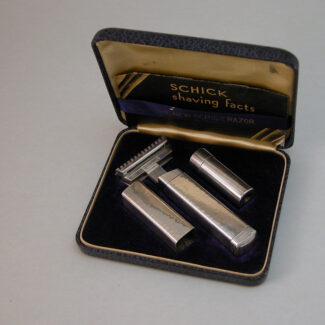Burley & Co (United States, 1871-1923)
Joseph Green
Edward Kemeys (American, 1847-1907)
Native Pitcher, c. 1895
redware
5 5/8” high x 9” wide (spout to handle)
Summary: Burley & Co pitcher made by Joseph Green and designed by Edward Kemeys (1847-1907) with elaborate relief of Native American portraits as spout, handle and either side the body, circa 1895. An innovative piece of Western redware pottery it incorporates stylized traditional indigenous motifs such as the Sgraffito bands along the base and rim. Kemeys is known to have sat with numerous figures in the Plains communities and it is very possible that the figures that adorn this object relate to ones sculptured from life.
The Art Institute of Chicago states that the Burley & Company likely commissioned the piece after Kemeys’ inclusion in the Columbian Exposition of 1893. Kemeys was a noted sculptor of animals and made numerous bronze plaque portraits of notable Plains Indians during his commission for the Marquette building in Chicago.
Markings: impressed on base in a round seal, “BURLEY & CO CHICAGO” / “AMERICAN” / “INDIAN PITCHER” / “MODEL BY” / “EDWARD KEMEYS” / “MADE BY” / “JOSEPH GREEN” / “OTTAWA ILL.”; signed on side, “Edward Kemeys” / Kemey’s Coyote Mark
Condition: Antique, Excellent Condition.
For Accuracy Only: there may be minimal signs of light wear commensurate with light use and age. The relief is high and the patina original.
Artist Biography: KEMEYS, Edward (American, 1843-1907) “Sculpture Edward Kemeys may be considered America’s first successful animalier sculptor. Born in Savannah, Georgia, and raised primarily in New York City, as a teenager Kemeys spent the summers with relatives in Dwight, Illinois, where he hunted the wildlife that would later serve as inspiration for his sculpture. After serving in the Union Army during the Civil War, he worked for the engineering corps… Despite formal training Kerneys made, in 1872-73, the first of several trips to the West. In Colorado, Wyoming, and New Mexico he lived among Indians and trappers while he hunted and studies wild animals in their natural habitat. By sculpting the likenesses of these already endangered creatures, and of Native Americans, Kemeys hoped to provide a naturalistic, scientific record. In May 1885 his works in several mediums were displayed in a one-person exhibition entitled “Wild Animals and Indians” at the Art Institute, and in 1892 Kemeys settled in Chicago to work on a number of sculptures for the World’s Columbian Exposition. After the fair he established a studio, dubbed Wolfsden, in the Bryn Mawr neighborhood and gave popular lectures on this art and adventures. In 1894 Kemeys’ monumental bronze lions were installed at the entrance of the recently constructed Art Institute building, where they remain today. In numerous public & private collections Kemeys bronze sculptures frequently fetch four to five figures at auction.
SOURCES: Window on the West (Barter); Art Institute of Chicago















